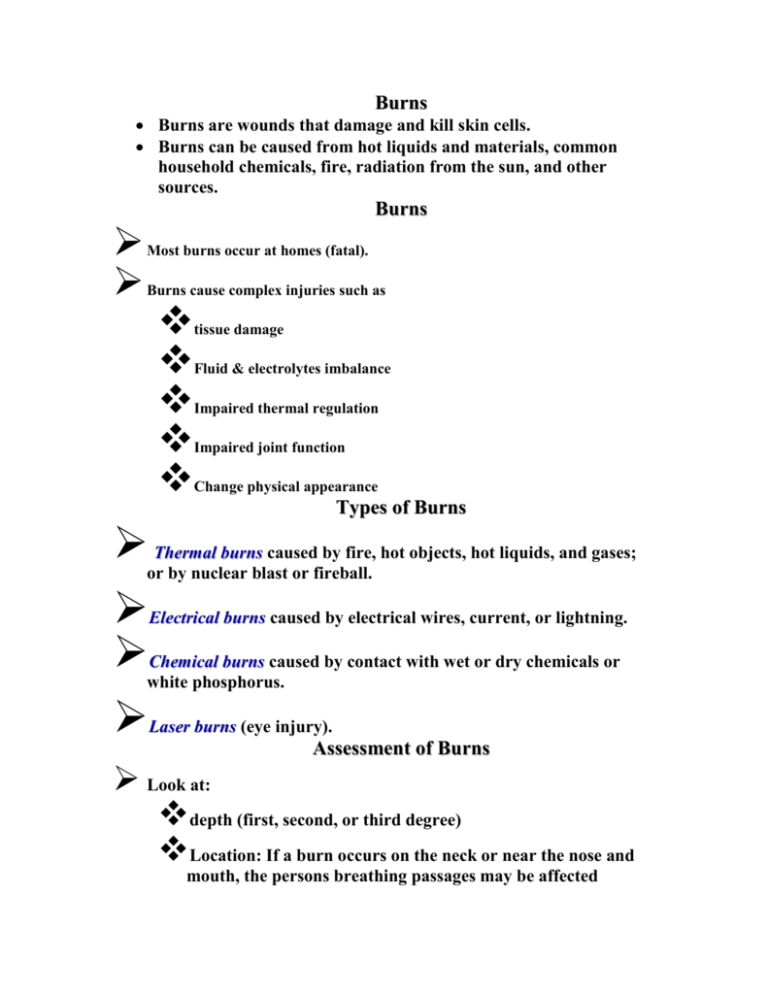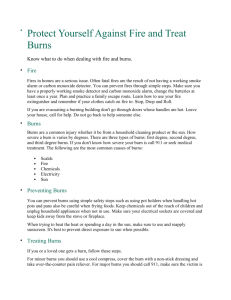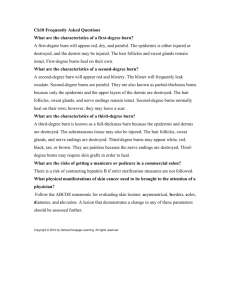Types of Burns
advertisement

B ur ns Burns are wounds that damage and kill skin cells. Burns can be caused from hot liquids and materials, common household chemicals, fire, radiation from the sun, and other sources. B ur ns Most burns occur at homes (fatal). Burns cause complex injuries such as tissue damage Fluid & electrolytes imbalance Impaired thermal regulation Impaired joint function Change physical appearance Types of Burns Thermal burns caused by fire, hot objects, hot liquids, and gases; or by nuclear blast or fireball. Electrical burns caused by electrical wires, current, or lightning. Chemical burns caused by contact with wet or dry chemicals or white phosphorus. Laser burns (eye injury). Assessment of Burns Look at: depth (first, second, or third degree) Location: If a burn occurs on the neck or near the nose and mouth, the persons breathing passages may be affected Area: the skin is a barrier to protect the body, and when it’s damaged, the victim is subject to fluid loss and infections. • If more then 15% of the body surface is damaged the victim can go into shock, and may require hospitalization for IV fluid and skin care. Prevention Keep household chemicals out of reach of children. Make sure hazardous chemicals are well marked and caps are screwed on tight. Keep hot object safely out of reach and make sure to turn off heaters and stovetops when finished. keep socket caps over all unused electrical sockets to protect against electrical shock. keep all electrical wires away from water. First-degree burn classifications of Burns The least serious burns in which only the outer layer of skin is burned (Epidermis) Second-degree burn when the first layer and the second layer of skin has been burned (Epidermis + Dermis) Third-degree burn The most serious burns are painless, involve all layers of the skin and cause permanent tissue damage. Fat, muscle and even bone may be affected. Sunburns A sunburn is the result of being exposed to too much of the suns ultraviolet radiation. Amount of sunlight depends on the geographic features, clothing, lifestyle and occupation. Indoors, sunburn-producing rays are filtered out by ordinary window glass. The suns rays are able to pass through light clouds, 25 cm of clear water, and fog. management of Minor Thermal burns minor burns includes first-degree and second-degree burns limited to an area less than 7.5 cm. in diameter Hold the burned area under cold running water for at least 5 minutes, or until the pain subsides. OR immerse it in cold water or cool it with cold compresses. Management of Minor Thermal burns Cover the burn with a sterile gauze bandage. Don't use fluffy cotton, which may irritate the skin. Wrap the gauze loosely to avoid putting pressure on burned skin. Bandaging keeps air off the burned skin, reduces pain and protects blistered skin. Give pain reliever. These include aspirin, ibuprofen (Advil), or paracetamol. Never give aspirin to children. Minor burns usually heal without further treatment. They may heal with pigmentation. Watch for signs of infection, such as increased pain Redness Fever swelling or oozing. If infection develops, seek medical help. Avoid re-injuring burns are less than a year old — doing so may cause more extensive pigmentation. Use sunscreen on the area for at least a year. Warnings Don't use ice. Putting ice directly on a burn can cause frostbite, further damaging of skin. Don't apply butter or ointments to the burn. This could prevent proper healing. Don't break blisters. Broken blisters are vulnerable to infection If the victim still on fire Quickly remove the victim from danger and cover the thermal burn with any large material (a jacket) If the victim clothing still on fire, roll the casualty on the ground to put out the flames. Management of Major Thermal burns dial 911. Until an emergency, follow these steps: Don't remove burnt clothing. However, make sure the victim is no longer in contact with flaming materials or exposed to smoke or heat. Don't immerse large severe burns in cold water. Doing so could cause shock. Check for signs of circulation (breathing, coughing or movement). begin CPR if needed. Elevate the burned body part above heart level. Management of Major Thermal burns Cover the area of the burn. Use a cool, moist, sterile bandage; clean, moist cloth; or moist towels. If fingers or toes are involved, place small nonstick gauze pads between the fingers and toes before bandaging. This will prevent from sticking together. Do NOT use oils or butter on a burn. Remove and constricting jewelry Manage Chemical burns Remove the cause of the burn by flushing the chemicals off the skin surface with cool, running water for 20 minutes or more. If the chemical is a powder-like substance, brush it off with a gloved hand or piece of cloth the skin before flushing. Remove contaminated clothing or jewelry and make sure not to contaminate yourself in the process Apply a cool, wet cloth or towel to relieve pain. Wrap the area loosely with a dry, sterile dressing or a clean cloth. Rewash the burned area for several more minutes if the person experiences increased burning after the initial washing. In case of an acid or alkali exposure to the skin or eye, immediately irrigate the affected area with plentiful amounts of water When to seek emergency assistance? If the victim has signs of shock. If the victim has difficulty in breathing. The chemical burn penetrated through the first layer of skin, and the resulting second-degree burn covers an area more than 7.5 cm. The chemical burn occurred on the eye, hands, feet, face, groin or buttocks, or over a major joint. The victim has pain that cannot be controlled with pain relievers . If you're unsure whether a substance is toxic. Electrical burns Manage Electrical burns An electrical burn may can extend deep into the tissues. If a strong electrical current passes through the body: a heart rhythm disturbance or cardiac arrest. the shake can cause the victim to be thrown or to fall, resulting in fractures or other injuries. Respiratory arrest result from injury to respiratory center in brain or paralysis of respiratory muscles. High voltage may cause temporary unconsciousness. Do not place yourself in danger by touching victim while the power is on. Turn off the power. Look first. Don't touch. The person may still be in contact with the electrical source. Touching the person may pass the current through you. Dial 911 if the person in pain, confused, or experiencing changes in breathing, pulse or consciousness. Turn off the source of electricity if possible. If not, move the source away from both you and the injured person using a dry non-conducting object made of cardboard, plastic or wood. Check for signs of circulation (breathing, coughing or movement). If absent, CPR immediately. Prevent shock. Lay the person down with the head slightly lower than the trunk and the legs elevated. Cover the affected areas. If the person is breathing, cover any burned areas with a sterile gauze bandage, if available, or a clean cloth. Don't use a blanket or towel. Loose fibers can stick to the burns.







